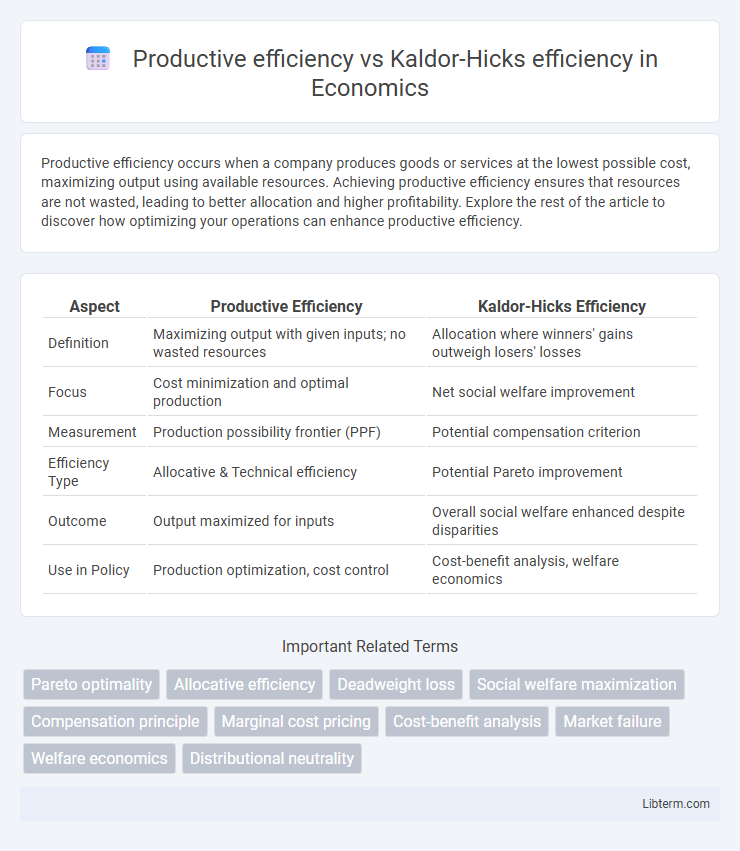Productive efficiency occurs when a company produces goods or services at the lowest possible cost, maximizing output using available resources. Achieving productive efficiency ensures that resources are not wasted, leading to better allocation and higher profitability. Explore the rest of the article to discover how optimizing your operations can enhance productive efficiency.
Table of Comparison
| Aspect | Productive Efficiency | Kaldor-Hicks Efficiency |
|---|---|---|
| Definition | Maximizing output with given inputs; no wasted resources | Allocation where winners' gains outweigh losers' losses |
| Focus | Cost minimization and optimal production | Net social welfare improvement |
| Measurement | Production possibility frontier (PPF) | Potential compensation criterion |
| Efficiency Type | Allocative & Technical efficiency | Potential Pareto improvement |
| Outcome | Output maximized for inputs | Overall social welfare enhanced despite disparities |
| Use in Policy | Production optimization, cost control | Cost-benefit analysis, welfare economics |
Defining Productive Efficiency
Productive efficiency occurs when goods or services are produced at the lowest possible cost, utilizing all resources fully without waste. This concept ensures that no additional output can be obtained from the same input, maximizing resource allocation. In contrast, Kaldor-Hicks efficiency focuses on overall welfare improvements, allowing for potential compensation among parties despite some losses.
Understanding Kaldor-Hicks Efficiency
Kaldor-Hicks efficiency occurs when the benefits to winners from a policy or economic change exceed the losses to losers, allowing for potential compensation that improves overall welfare without requiring actual compensation payments. Unlike productive efficiency, which focuses on maximizing output with given inputs, Kaldor-Hicks efficiency emphasizes allocative improvements and net social welfare gains, even if some parties are worse off. This concept is often used in cost-benefit analysis to justify projects or policies that increase total economic value despite distributional inequalities.
Key Differences Between the Two Concepts
Productive efficiency occurs when goods or services are produced at the lowest possible cost, utilizing resources optimally to maximize output. Kaldor-Hicks efficiency emphasizes potential compensation, where an allocation is efficient if those who benefit could theoretically compensate those who lose, enabling net social gains. The key difference lies in productive efficiency's focus on cost minimization in production, while Kaldor-Hicks efficiency prioritizes overall welfare improvement regardless of distribution.
The Role of Resource Allocation
Productive efficiency occurs when resources are allocated to maximize output without waste, ensuring the optimal combination of inputs and outputs in production processes. Kaldor-Hicks efficiency evaluates resource allocation based on overall economic welfare, where reallocations improve total gains even if some parties are worse off, provided the winners could theoretically compensate the losers. Resource allocation under productive efficiency focuses on technical optimality within production, while Kaldor-Hicks efficiency emphasizes welfare improvements across the economy despite potential distributional trade-offs.
Measuring Efficiency in Economic Systems
Productive efficiency occurs when goods and services are produced at the lowest possible cost, maximizing output from given inputs, while Kaldor-Hicks efficiency evaluates economic outcomes based on potential compensation, allowing reallocations where winners could theoretically compensate losers. Measuring efficiency in economic systems involves comparing resource allocation against these benchmarks: productive efficiency assesses cost minimization and output maximization, whereas Kaldor-Hicks efficiency measures net social welfare changes disregarding actual compensation. Empirical analysis often uses cost functions and welfare metrics to quantify the degree of efficiency improvement under differing policy scenarios.
Real-World Examples: Productive vs. Kaldor-Hicks
Productive efficiency occurs when goods are produced at the lowest possible cost, exemplified by manufacturing firms optimizing resource use to minimize waste. Kaldor-Hicks efficiency, often applied in policy analysis, allows for some parties to be worse off as long as gains to others outweigh losses, as seen in infrastructure projects where benefits exceed costs despite some community displacement. Real-world examples include a factory reducing production expenses for productive efficiency versus a government approving a highway expansion for Kaldor-Hicks efficiency despite social costs.
Implications for Policy and Decision-Making
Productive efficiency ensures resources are used to maximize output without waste, guiding policies toward optimal production methods and cost minimization. Kaldor-Hicks efficiency evaluates policy changes by potential compensation to losers, allowing decisions that increase overall social welfare despite unequal benefits distribution. Policymakers must balance strict resource optimization with broader welfare gains, incorporating compensation mechanisms to justify reforms that improve aggregate efficiency but generate redistributional effects.
Limitations of Each Efficiency Criterion
Productive efficiency, which occurs when goods are produced at the lowest possible cost, fails to account for the distribution of resources and may overlook equity considerations, limiting its applicability in welfare analysis. Kaldor-Hicks efficiency emphasizes potential compensation and overall social welfare gains but often ignores the practicality of compensation and can justify outcomes that disadvantage certain groups, raising concerns about fairness. Both criteria face limitations in addressing distributional impacts and real-world implementation challenges, making them insufficient as sole measures of economic efficiency.
Achieving Optimal Outcomes in Practice
Productive efficiency occurs when resources are utilized to produce the maximum output at the lowest cost, ensuring that no inputs are wasted, while Kaldor-Hicks efficiency assesses whether an allocation of resources can make at least one individual better off without making others worse off in net terms. Achieving optimal outcomes in practice involves balancing these efficiencies by maximizing total economic surplus while considering distributional impacts and compensations. Real-world applications often require policy interventions or market mechanisms to adjust for externalities and information asymmetries, facilitating moves toward both productive and Kaldor-Hicks efficiencies.
Productive Efficiency vs. Kaldor-Hicks: Which Matters Most?
Productive efficiency occurs when goods are produced at the lowest possible cost, maximizing resource utilization without waste. Kaldor-Hicks efficiency evaluates economic policies based on potential gains outweighing losses, even if some parties are worse off, emphasizing overall welfare improvement. In policy decisions, Kaldor-Hicks efficiency often matters more because it allows trade-offs and compensations that productive efficiency alone cannot capture, addressing broader societal welfare beyond mere cost minimization.
Productive efficiency Infographic

 libterm.com
libterm.com